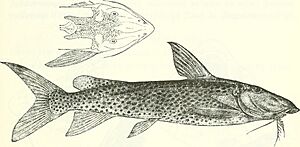Synodontis guttatus facts for kids
Quick facts for kids Synodontis guttatus |
|
|---|---|
 |
|
| Conservation status | |
| Scientific classification | |
| Genus: |
Synodontis
|
| Species: |
guttatus
|
The Synodontis guttatus is a special kind of upside-down catfish. It lives in the Niger River basin in Nigeria. A German fish expert named Albert Günther first described this fish in 1865. He found it in the Niger River. The name guttatus comes from a Latin word meaning "spotted." This is because the fish has spots on its fins and body.
Contents
About This Fish
Like other Synodontis catfish, S. guttatus has a strong, bony head. This head bone goes all the way back to its first dorsal fin spine. It also has a unique bony part on its shoulder area called a humeral process. The shape and size of this part help scientists tell different Synodontis species apart. For S. guttatus, this humeral process is rough and much longer than it is wide. It also has a pointed end.
Its Whiskers and Fins
This fish has three pairs of barbels, which are like whiskers. One pair is on its upper jaw, and two pairs are on its lower jaw. The upper jaw barbels are long and straight. They are about three-quarters the length of its head. The outer pair of lower jaw barbels is almost twice as long as the inner pair. These lower barbels have small branches on them.
The front edges of the dorsal fin (on its back) and pectoral fins (on its sides) are stiff spines. The dorsal fin spine on S. guttatus is about three-quarters the length of its head. It is smooth on the front but has a saw-like edge on the back. The rest of the dorsal fin has seven soft rays. The pectoral fin spine is about the same length as the dorsal spine. It has saw-like edges on both sides. The adipose fin, a small fleshy fin, is three times longer than it is deep. The anal fin has three unbranched rays and eight branched rays. It is pointed at the front. The tail fin, also called the caudal fin, has a deep notch.
Its Mouth and Teeth
All Synodontis fish have a special pad of teeth on the very front of their upper jaw. This pad has several rows of short, chisel-shaped teeth. In S. guttatus, this tooth pad is wide and shaped like a crescent moon. On its lower jaw, the teeth are attached to flexible stalks. They are often described as "s-shaped" or "hooked." The number of teeth on the lower jaw helps identify different species. S. guttatus has about 30 teeth on its lower jaw.
Color and Size
The main body color of this fish is brown. It is covered with many small, round, dark spots.
The Synodontis guttatus can grow up to about 70 centimeters (27.5 inches) long. Generally, female Synodontis fish are a bit larger than males of the same age.
Where it Lives and How it Behaves
In the wild, this fish is only found in one place in Nigeria. This is in the lower part of the Niger River. People catch this fish for food.
Protecting This Fish
The main dangers to this fish are pollution in its home and the small area where it lives. Because of these threats, it is listed as an endangered species. This means it is at high risk of disappearing forever.
Reproduction and Life Cycle
Scientists do not know much about how most Synodontis species reproduce. They have found eggs inside some female fish. It is likely that these fish lay their eggs during the flooding season. This usually happens between July and October. During this time, pairs of fish probably swim together to lay their eggs. Young fish grow very quickly in their first year. After that, their growth slows down as they get older.


